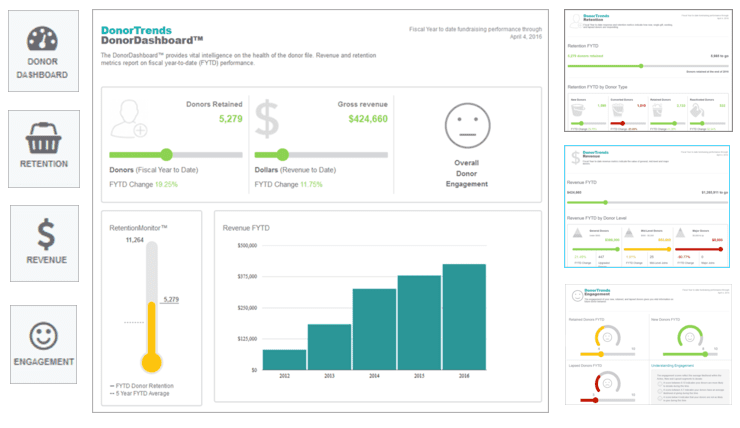Metrics for Fundraising: Donor Retention Made Easy!
Today we have a special guest post from fundraising guru Roger Craver of The Agitator Blog. He joined us for a private webinar with our INSIDERS this week: Donor Retention Made Easy. During his webinar, he outlined the importance of tracking two key performance indicators that can predict your organization’s fundraising future: “retention rate” and “lifetime value.” I personally think we don’t pay enough attention to these “vital signs” that measure the health and lifeblood of our fundraising programs.
These Are THE Metrics for Fundraising You Need To Track.
Here is Roger Craver’s take on metrics that can help you boost donor retention: Unlike ‘vanity metrics’ (See my Agitator post on vanity metrics for more detail), a metric that matters – is one that triggers the “What-should-I-do-differently-to-improve?” question.
Preview Bonus for Fired-Up Fundraising Subscribers
After I list and explain what I consider ‘must know’ metrics that matter, I’m going to provide a link that will enable you to quickly — and for free — analyze your own file in just minutes for metrics that matter. This is a courtesy offered to members of Fired-Up Fundraising by DonorTrends. A number of your fellow Fired-Up Folks have already taken advantage of this opportunity and I urge you to do the same. It’s FREE. The good folks at DonorTrends will not only show you how to analyze your own file, but if you need help they’ll take the time to do that as well.

Key Metrics Here are my picks for Fundraising Metrics That Really Matter because they lead us to ask key questions. Questions that, when answered, can dramatically improve the productivity of a fundraising program. In my mind a ‘key metric’ is one that provides the sort of information that, if you act on it, will affect the value of your donor base. Much like the basic ‘vital signs’ of the human body — blood pressure, pulse, heart rate, BMI, etc. — key fundraising metrics will enable you to spot problems, see opportunities, and take action to improve your organization’s financial growth and sustainability. (Helpful resource: The Agitator Archives are packed with helpful articles, tips and case studies involving each of these metrics. Just go to Search Archives on the Agitator’s homepage, enter some search terms and … bingo! )
Number of New Donors Making Second Gift.
This metric is a harbinger, if not a dead-on predictor of the retention rates and Life Time Value (LTV) an organization is likely to enjoy. Ask and correctly answer the question of how to get more second gifts and get them earlier and you’ll have a head start on a higher retention rate. But first you must find out how many new donors do and how many don’t make second gifts.
First Year Retention Rate.
The Agitator has preached and preached about lousy retention rates and begged everyone to fix the leaky bucket of retention. It begins with the new donors, what we do to hold them, what we do to lose them. There are tons of questions and hypotheses you should be putting forth around this metric once you determine the number of new donors retained into the second year.
The flip side of the retention coin is ‘attrition.’
Here the questions start with: “Why did so many donors leave?” Ask and answer this question by identifying (and correcting) the causes of defection. And you’ll not only boost your bottom line, you’ll make your acquisition investment pay off faster and better.
Multiple Year Retention Rates.
Same as above, but by tracking these year-by-year you can spot trends, problems and opportunities, because year-over-year comparisons of this metric will trigger additional questions and answers for improving your program.
Lifetime Value of a Donor (LTV).
At the end of the day all the actions you take to improve retention, average gift, and donor commitment will be reflected in the LTV value of each donor and all donors collectively. This is the Key Metric on which you can benchmark, guide and then track the success — or failure — of your intermediate and long term strategies.
Annual Metrics for Fundraising.
Much like marking a child’s growth on a wall or door jamb year by year you’ll also want to track your annual improvements (or improvement opportunities). Here’re my choices and I think their labels are self-explanatory. Each should trigger questions that lead to action. For example, if the ‘Number of Gifts per Donor’ is lower this year than last, then “What did we do differently this year compared to last year?” Or if the ‘Lapsed Reactivation Rate’ is higher this year than last, “What did we do differently this year, and should we be doing more of it?”
- 5 Year Lifetime Value
- Average Gift
- Revenue per Donor
- Number of Gifts per Donor
- $ and or % of gifts that have been upgraded
- Growth score (is your donor base growing or shrinking)
- Lapsed Reactivation Rate
Now … Your Free Bonus.
You can quickly and easily get each of the metrics above — and more — for your own file presented on a dashboard created just for you by going to this special Fired-Up Fundraising/DonorTrends Sign Up Page to get started. It’s free and if you need help the folks at DonorTrends are standing by to assist you and answer questions. Your metrics and an analysis of your file will be ready in minutes. Remember, what gets measured is usually what gets managed. So start measuring with metrics that really matter to your organization’s future. Roger



